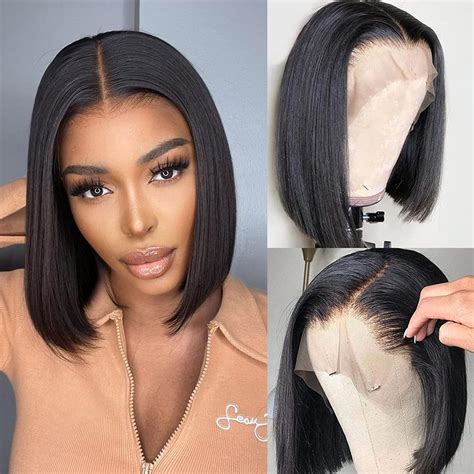The Human Hair Wig Market: A Booming Industry
The global human hair wig market is projected to reach USD 12.5 billion by 2025, exhibiting a CAGR of 6.2% during the forecast period. The rising demand for natural-looking and versatile hair solutions, coupled with the growing disposable income in developing countries, is driving market growth.

Top 5 Trends Shaping the Wigs Human Hair Landscape
- Technological Advancements: Innovations in wig-making techniques, such as lace front wigs and 3D printing, are enhancing the realism and comfort of wigs.
- Customization and Personalization: Consumers are increasingly seeking wigs that are tailored to their unique facial features and hair preferences.
- Synthetic Hair Blends: Synthetic hair fibers are becoming more sophisticated, offering a wider range of colors, textures, and heat resistance.
- Online Sales and Global Reach: E-commerce platforms are expanding the accessibility of human hair wigs, enabling customers to purchase wigs from anywhere in the world.
- Celebrity Endorsements: Prominent figures in the entertainment industry have been endorsing human hair wigs, increasing their popularity and acceptance.
The Art of Wig-Making: A Delicate Craft
The creation of a high-quality human hair wig involves craftsmanship and attention to detail.
Process:
- Raw Material Selection: Human hair is sourced from various countries, considering factors such as texture, color, and quality.
- Weft Preparation: The hair strands are sewn onto thin strips of fabric or lace, creating wefts.
- Cap Construction: A cap made of breathable material is used as the base of the wig.
- Wig Assembly: The wefts are carefully attached to the cap, following a specific pattern to achieve the desired look.
- Styling and Finishing: The wig is styled to create the desired volume, length, and texture.
Benefits:
- Natural Appearance: Human hair wigs mimic the natural texture and movement of real hair, providing a flattering and seamless look.
- Versatility: Wigs allow for instant hair transformations, enabling wearers to change their hair color, length, and style without damaging their natural hair.
- Scalp Protection: Wigs can protect the scalp from sun exposure, chemicals, and other environmental factors.
- Hair Loss Solutions: Wigs provide a discreet and comfortable solution for those experiencing hair loss due to medical conditions or alopecia.
- Confidence Boost: A well-fitted and styled human hair wig can significantly enhance confidence and self-esteem.
Applications:
- Fashion and Beauty: Wigs are used by fashion enthusiasts, celebrities, and everyday individuals to create distinctive and glamorous looks.
- Cosplay and Performance: Wigs are essential for costuming in theater, film, and cosplay events, allowing actors to embody different characters.
- Medical and Hair Loss Solutions: Wigs provide a discreet and comfortable way to conceal hair loss due to medical treatments or hair disorders.
- Cultural and Religious Expressions: Wigs are used in various cultures and religions to adhere to specific customs and religious practices.
- Wig Therapy: Wigs can be used as a therapeutic tool to help individuals cope with the emotional and psychological impact of hair loss.
To prolong the lifespan of a human hair wig, proper care and maintenance are essential.
Effective Strategies:
- Regular Washing and Conditioning: Wash the wig with sulfate-free shampoo and condition it regularly to keep it clean and prevent tangles.
- Detangling: Gently detangle the wig using a wide-toothed comb or a wig brush.
- Heat Styling: Use heat protectant spray before using heat styling tools to minimize damage to the hair.
- Proper Storage: Store the wig on a wig stand or in a breathable bag when not in use to maintain its shape.
- Professional Wig Care: Consider professional wig maintenance services for deep cleaning, styling, and repairs to extend its lifespan.
Table 1: Types of Wig Constructions
| Construction Type | Description |
|---|---|
| Lace Front Wig | Creates the illusion of a natural hairline using a lace or mesh base. |
| Monofilament Wig | Provides a realistic scalp appearance with individual hair strands hand-tied to a thin, transparent base. |
| Machine-Made Wig | Made using a machine to sew wefts onto a cap, offering durability and affordability. |
| Hand-Tied Wig | Meticulously hand-sewn, creating a natural and breathable wig that mimics real hair growth. |
Table 2: Human Hair Wig Quality Grades
| Grade | Description |
|---|---|
| Remy Hair | Cuticles are aligned in the same direction, resulting in smooth and tangle-free hair. |
| Non-Remy Hair | Cuticles are not aligned, making it more prone to tangling and matting. |
| Virgin Hair | Unprocessed and chemically untreated, ensuring the highest quality and durability. |
| Processed Hair | Treated with chemicals to alter color, texture, or curl pattern, potentially affecting its longevity. |
Table 3: Hair Density Options for Human Hair Wigs
| Density | Description |
|---|---|
| 100-130% | Light density, providing a natural look with volume and movement. |
| 150-180% | Medium density, creating a fuller and more voluminous appearance. |
| 200% and above | High density, suitable for bold and dramatic looks, but may require more styling effort. |
Table 4: Wig Cap Sizes and Measurements
| Cap Size | Head Circumference |
|---|---|
| Small | 20.5-21.5 inches |
| Medium | 21.5-22.5 inches |
| Large | 22.5-23.5 inches |
| Custom | Measurements taken specifically for the wearer’s head size |
| Petite | Designed for individuals with a smaller head size |
